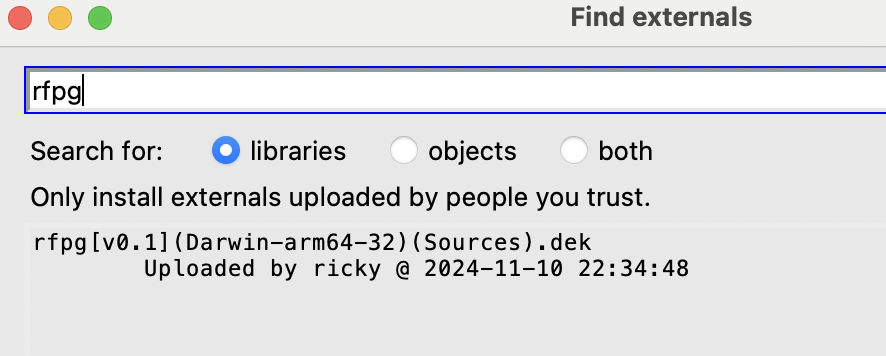-
 ricky
posted in this forum • read more
ricky
posted in this forum • read moreMaybe it's because they're a fictional character from Pokemon?
-
-
-
 ricky
posted in technical issues • read more
ricky
posted in technical issues • read moreI pushed an update with intel but it's still showing the older version? How long does it take to catch up or do I need to remove a prior commit somehow?

-
 ricky
posted in extra~ • read more
ricky
posted in extra~ • read moreI wrangled my externals into one library of sorts. You can grab rfpg from Deken for macOS for the moment.
Includes:
- audio-rate ambisonics externals
- time-domain granular sampling external
- tonal pitch space model for an incoming sequence of MIDI pitch data
- tape delay synth
- fibonacci rhythm generator

More later!
-
-
-
 ricky
posted in technical issues • read more
ricky
posted in technical issues • read moreHow does one submit a library via Deken? What is the process?
-
 ricky
posted in technical issues • read more
ricky
posted in technical issues • read moreI don't have a great answer but it made me wonder if you've seen William Brent's new project OUTPUT? https://github.com/wbrent/OUTPUT
I believe he's using JackTrip to jam online.
https://github.com/jacktrip/jacktrip/releases/tag/v1.4.0-rc.5 -
 ricky
posted in technical issues • read more
ricky
posted in technical issues • read moreI thought the cosine shape was really just convenience given that [cos~] is available and that allows for a sample-accurate solution that doesn't involve reading from a table.
-
 ricky
posted in technical issues • read more
ricky
posted in technical issues • read more@whale-av said:
@katjav gave it a lot more thought here........ https://www.katjaas.nl/pitchshift/pitchshift.html
I could be wrong but I don't see why the samplerate would be part of the calculation (it isn't)...... as all variables are relative.I was confused because R represents sample rate earlier in the text.
"If the frequency of the sawtooth wave is $f$ (in cycles per second), then its value sweeps from 0 to 1 every $R/f$ samples (where $R$ is the sample rate)."
-
 ricky
posted in technical issues • read more
ricky
posted in technical issues • read more@whale-av said:
@ricky It's [- 1] because the exponent of 0 (no shift) is 1 but the tape head has to be stationary (no rotation = 0) for playback at normal speed......
Ah, thanks. That makes sense. Thanks, David.
And [* -1] because (although it seems wrong until you really think about it) the tape head has to be turning backwards relative to the tape (negative values for [phasor~]...) for the pitch to increase (positive transposition values).
There is no point arguing with the patch because it works as expected.......
Who is arguing?
 This was my understanding.
This was my understanding.[cos~] windows the output so that amplitude sums are "sort of" ok (with the in and out of phase bits) and the vertical edge of the [phasor~] saw is declicked.
Yes, a nicely scaled fade in and out.
-
 ricky
posted in technical issues • read more
ricky
posted in technical issues • read moreCocktail hour is the best hour. Good man and good catch! I totally forgot about the 0.001 multiplier and of course it factors it out. D'oh. As for the [* -1], I thought this made sense in the context of the Pd patch given the positive ramp of the phasor and without it the pitch transposition step is inverted.
What you're saying is that the algebra below is incorrect? Maybe it has something to do with the way the transposition factor is calculated?

It's too early for a cocktail here. Still on my first coffee.

